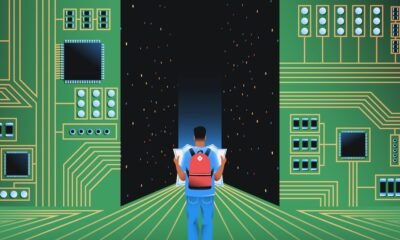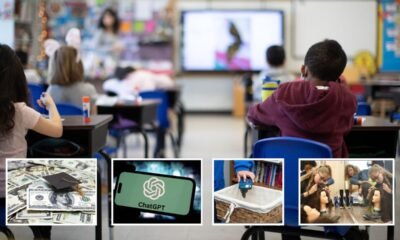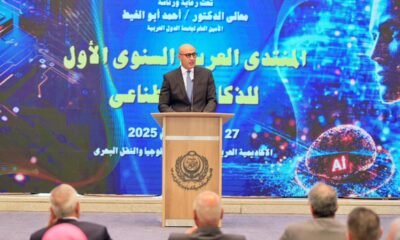Education
Artificial Intelligence in Education: Transforming Learning for the Next Generation

In 2025, education is undergoing its most profound transformation in decades, driven by rapid advances in artificial intelligence (AI). Once confined to science fiction, AI is now reshaping how students learn, how teachers teach, and how educational institutions operate. This isn’t just about robots in classrooms—it’s about a smarter, more personalized, and more accessible approach to lifelong learning.
But what does this AI-driven future really look like? And what challenges and opportunities does it bring for students, teachers, and society as a whole? Let’s dive into the world of AI in education.
The AI Revolution: What’s Different Now?
Artificial intelligence, in simple terms, refers to machines and software that can “think,” learn, and make decisions much like humans. In the past, educational technology was limited to online videos, quizzes, and digital textbooks. Today, AI goes several steps further, enabling truly adaptive, interactive, and data-driven learning experiences.
Key advances fueling this shift include:
Natural Language Processing (NLP): AI systems can understand and respond to spoken or written language, making tutoring and feedback much more accessible.
Machine Learning: Algorithms analyze student performance and adapt content in real time.
Automation: Tasks like grading, scheduling, and even basic counseling are being streamlined, giving educators more time to focus on human interaction.
Personalization: Every learner receives a path tailored to their strengths, weaknesses, pace, and interests.
Personalized Learning: No More One-Size-Fits-All
Traditional education systems often struggle to accommodate different learning styles and paces. In a class of 30, some students feel lost while others are bored. AI changes this by providing real-time, personalized feedback and resources.
How it works:
Adaptive learning platforms (like Khan Academy, Squirrel AI, or DreamBox) adjust difficulty, offer targeted exercises, and recommend supplementary materials based on each learner’s progress.
AI-powered tutors identify areas where a student is struggling and offer step-by-step guidance, hints, or alternative explanations.
Voice assistants (such as AI tutors on tablets or smart speakers) answer questions, quiz students, and reinforce learning—any time, anywhere.
The result? Students progress at their own pace, build confidence, and develop a stronger grasp of material.
Smart Classrooms: Where Technology Meets Teaching
In 2025, the classroom itself is evolving. Interactive whiteboards, real-time translation, and augmented reality (AR) overlays are already common in many schools.
AI-powered tools in the classroom include:
Attendance and Participation Monitoring: Cameras and sensors (with appropriate privacy safeguards) track participation and flag students who may need extra help.
Automated Assessment: Instant grading for quizzes, essays, and even spoken presentations frees teachers to focus on higher-level feedback and mentoring.
Behavior and Engagement Analytics: AI analyzes patterns (such as distraction or confusion) and prompts teachers with strategies to re-engage learners.
Supporting Teachers, Not Replacing Them
A common fear is that AI might replace teachers. In reality, the opposite is true—AI augments what teachers do best: inspiring, mentoring, and connecting with students.
Key benefits for educators:
Administrative Relief: Automated grading, scheduling, and reporting reduce paperwork and burnout.
Professional Development: AI recommends tailored training and resources to help teachers continually grow.
Classroom Insights: Real-time data on student engagement and performance allow teachers to target support where it’s needed most.
By taking over repetitive tasks, AI gives teachers more time to create meaningful relationships with students.
Making Learning Accessible for All
One of the most exciting promises of AI is making education more inclusive and accessible.
Examples:
Real-Time Translation: Language barriers are broken down with instant translation of instructions, lessons, and conversations.
Assistive Technology: AI-driven tools convert speech to text (and vice versa), describe images for visually impaired students, or provide sign language interpretation.
Personalized Pacing: Students with learning differences (like dyslexia or ADHD) receive resources tailored to their needs—improving outcomes for all.
In remote or underserved communities, AI-powered apps and virtual tutors provide high-quality instruction even when teachers are scarce.
AI and Lifelong Learning
In a rapidly changing job market, learning doesn’t stop after graduation. AI is powering new models of lifelong education.
Skill Platforms: Coursera, Udemy, and LinkedIn Learning use AI to recommend courses and build adaptive career pathways.
Corporate Training: Companies deploy AI to upskill workers on the fly, identifying knowledge gaps and delivering targeted micro-lessons.
Credentialing and Portfolios: AI helps track and verify skills, creating digital “learning passports” for individuals.
Challenges and Ethical Considerations
The AI education revolution isn’t without challenges.
1. Data Privacy and Security
AI systems require huge amounts of data to function. Protecting student privacy, securing sensitive information, and ensuring ethical use of data is paramount.
2. Bias and Fairness
AI models can unintentionally reflect or amplify existing biases if not carefully designed and monitored. Continuous auditing and diverse data sets are essential to avoid unequal treatment or opportunity.
3. The Digital Divide
Not every student has equal access to devices or high-speed internet. Bridging the gap is a major priority, with governments, nonprofits, and companies working to provide devices and affordable connectivity.
4. Over-Reliance on Technology
AI is a powerful tool, but not a panacea. Human relationships, critical thinking, and creativity cannot be fully automated. Blending AI with traditional, face-to-face education is crucial for balance.
The Human Side: Social and Emotional Learning
While AI can teach math or science, human teachers excel at nurturing empathy, teamwork, and resilience. In 2025, the best classrooms blend the efficiency and personalization of AI with programs focused on social and emotional skills, ethics, and creativity.
Looking Forward: The Future of AI in Education
The journey is just beginning. Over the next decade, expect:
More immersive experiences with AR/VR and AI-powered simulations (e.g., exploring ancient Rome or conducting virtual science experiments).
AI-driven mentorship—matching students with real-world experts for guidance and networking.
Global classrooms—students from around the world collaborating and learning together, with AI bridging languages and time zones.
The ultimate goal: an education system that’s more flexible, inclusive, and effective for every learner.
Conclusion: Learning, Transformed
AI is not here to replace teachers or make learning soulless. It’s here to empower students, free up educators, and open doors for millions. As AI continues to evolve, the promise is clear: smarter, more personalized, and more accessible education for everyone—no matter where they live or how they learn.
The challenge is to use this technology wisely, ethically, and with a focus on what really matters: preparing the next generation not just for exams, but for life.
Education
More parents to get childcare funding as nurseries battle demand

Vanessa ClarkeEducation reporter
 Vanessa Clarke/BBC
Vanessa Clarke/BBCThe final phase of the largest-ever expansion of publicly funded childcare support has begun in England, as thousands of working parents receive more help with their nursery costs.
Those eligible are now able to access 30 hours of childcare per week during term-time, paid for by the government, for their children aged nine months to four years.
Prime Minister Sir Keir Starmer said it was a “landmark moment” for working families, and that the scheme would “put money back in working parents’ pockets”.
But parents say they are facing long waiting lists for places, with nurseries warning that staff shortages are limiting their availability.
Parents Josh Harper and Chloe Hart say their 18-month-old son Oakley’s name was the first one on the waiting list at his new nursery in Altrincham.
The £240-a-month saving on fees, which are falling from £1,130 to £889 because of the scheme extending from 15 hours to 30 hours of funded care, “just releases that little bit of stress”, mum Chloe says.
“It is a significant saving and one that does really help us,” dad Josh adds.
Both teachers, the couple were keen to secure a place, aware that demand has been rising.
 Chloe Hart
Chloe HartThe government had estimated that about 70,000 extra places would be needed by this September to accommodate that increase in demand.
The number of spaces is rising but availability varies across the country – and nurseries and childminders say inquiries for places have “gone through the roof” from families eligible for the extra funding.
“A few years ago, the percentage of families getting the funding was probably 20%, now I’d say it’s nearly 95% of families,” George Apel says as he shows me around the newly opened Altrincham Day Nursery, the Apel family’s seventh nursery.
“Parents are having to be a lot more flexible with their acceptance of what days are available. Before, parents could try to match their childcare to their job, now they’re actually matching their job to their childcare availability.”
For Rachael Darbyshire, who lives in Bolton, the search for a childcare place for her return to work next summer has proved challenging.
Although she started her search before six-week-old Gabriel was born, all of her local nurseries have waiting lists up until September 2026.
“It is a massive help and will bring our bill down from £1200 to around £800, but the biggest issue is that it is only great if you can actually get a childcare place,” Rachael says.
“It’s all well and good saying that there are these hours available, but if the childcare places are not there, then it’s not really supporting women in returning to work.”
 Vanessa Clarke/BBC
Vanessa Clarke/BBCSome parents are going to extra lengths to make themselves eligible for the funded hours as early as possible.
Rachel Williams, from Warwick, says she was thinking about the scheme before the birth of her twins in 2022, when doctors told her she would need a Caesarean four weeks early.
She opted to have the procedure at the end of that March, rather than the beginning of April, so she wouldn’t miss the deadline for being eligible for funded hours at the start of the April term.
“My friends all laughed at me, but it was a really conscious decision and it’s definitely saved us thousands and thousands of pounds,” she says.
If the twins were born in April, they wouldn’t have been eligible for funded hours until the September entry points.
“You shouldn’t really have to be thinking about that,” Rachel says.
 Rachel Williams
Rachel WilliamsResearch from the National Foundation for Educational Research (NFER) suggests that workforce issues could be a key barrier to delivering the promised offer to parents, with low pay and limited progression opportunities a constant challenge for staff.
It is estimated the sector needs 35,000 more staff to provide the funded hours expansion, and the NFER says even if that figure is reached, there are likely to be regional discrepancies.
The government says the number of staff delivering funded childcare in nurseries rose to 272,500 this year – up by 18,200 from 2024, which it said was the highest increase on record.
It has been offering a £1,000 incentive for new recruits, or for people rejoining the workforce in some areas.
But Mr Apel says “retention is arguably more important than recruitment”.
The nursery has started its own recruitment company because of the struggle to bring in and keep early years workers.
The number of childminders has also been continuing its long-term decline, with Ofsted figures showing the numbers falling by 1,000 in the last year.
‘Free’ childcare
There has also been confusion around what is “free” as part of the scheme, and what has to be paid for.
The government-funded hours cover term-time only, and providers say the funding rates, particularly for children aged three and four, are lower than the costs.
It means many nurseries are putting up their prices. A University of Bath study tracking fees over the past 18 months found that they have risen fastest in areas with the lowest government funding, which it says could deepen regional inequalities.
“Parents are phoning up, they’re looking for this thing that’s been called ‘free’, and then they are met with additional charges, for meals or nappies,” says Sarah Ronan, from the Early Education and Childcare Coalition, which represents childcare providers and charities.
“The sector has been tasked with rolling out the biggest expansion of childcare in history, and they’re doing it in a really constrained financial environment.”
She says without extra funding, providers may reduce the number of hours they can offer and pause their recruitment plans, further limiting the availability of places.
Joeli Brearley, founder of the Pregnant The Screwed campaign group and the parent support programme Growth Spurt, says there is “a tussle between parents and providers” who are both struggling.
“For parents, it’s really complicated, it’s not really working,” Ms Brearley says.
“We are hearing from parents who are moving their C-section day in order to fit in with the funding criteria, we’re hearing from women who say they’ve gone to their midwife for a sweep to try and bring labour on faster, and people that are asking for inductions earlier just so they can fit with the funding criteria – and that is madness.”
A survey by Growth Spurt and Women in Data suggests that many parents are paying extra consumable fees of £15 a day.
The government has issued guidance saying any additional costs need to be laid out clearly and are optional, but nurseries say charging for extras is the only way to make up the shortfall.
 Vanessa Clarke/BBC
Vanessa Clarke/BBCThere is also concern about those being left out.
Parents who are ineligible for the entitlements pay £205 per week more for a child under two, according to Coram Family and Childcare.
The charity says a child with working parents eligible for the entitlements will receive three times as much government-funded early education than a disadvantaged child by the time they start school.
Education Secretary Bridget Phillipson said the scheme was designed to give children “the best start in life”, and provide a “huge boost” to the economy.
“And this is just the beginning,” she added.
“My vision for early years goes beyond this milestone. I want access to high-quality early years for every single family that needs it, without strings and without unfair charges.
“Over the next few years, that is my commitment to parents.”
Education
US Education Department is all for using AI in classrooms: Key guidelines explained

Artificial intelligence (AI) has moved from being a futuristic concept to an active part of classrooms across the United States. From adaptive learning platforms to AI-powered lesson planning, schools are integrating technology to improve learning outcomes and ease teacher workloads. However, the challenge lies in adopting these tools without violating federal and state regulations.
Federal guidance: Innovation with safeguards
In July 2025, the US Department of Education issued guidance confirming that AI can be used in schools when aligned with federal laws. The framework focuses on three core principles—privacy, equity, and human oversight.AI tools must comply with the Family Educational Rights and Privacy Act (FERPA) to protect student data. Algorithms should be designed to prevent bias or discrimination under civil rights regulations. Human decision-making must remain central, ensuring that AI supports educators rather than replacing them.The Department also encouraged schools seeking federal grants to propose AI-driven projects, provided they meet these compliance standards.
State-level action: Rapid policy development
Since the federal guidance, more than half of US states have introduced their own AI frameworks for schools. Ohio now mandates that all districts adopt an AI-use policy by mid-2026, while Rhode Island has published detailed recommendations for responsible classroom integration.These local rules aim to ensure innovation while safeguarding student interests. However, the pace of policy development and the diversity of approaches have created a complex regulatory environment for schools.
Mixed practices at the local level
Despite progress, many districts still operate in a gray area. Policies differ widely between schools, and families often face uncertainty about what is permissible. Some institutions allow AI on personal devices while banning it on school-owned systems. In certain cases, schools have reverted to traditional measures, such as requiring handwritten essays in class to prevent AI-assisted work.This variation highlights the need for consistent guidelines and clear communication with students and parents.
AI as a classroom resource
Educators are increasingly using AI as a tool for efficiency and creativity. AI platforms assist in lesson planning, assessment design, and content generation, enabling teachers to save significant time on administrative work. These efficiencies allow more focus on interactive teaching and student engagement.AI-powered tutoring systems are also being introduced to provide personalised support, particularly for students who need extra academic help. States such as New Hampshire are experimenting with AI-driven tools to enhance math and reading instruction.
Responsible AI use: Best practices for schools
To remain compliant and maximise benefits, schools should adopt structured approaches to AI integration:
- Personalised Learning: Use adaptive platforms to tailor lessons while ensuring compliance with privacy regulations.
- Teacher Support: Allow educators to use AI for planning and administrative tasks with mandatory human review.
- Assessment Integrity: Shift from take-home essays to in-class writing or oral presentations to discourage misuse.
- Career Guidance: Deploy AI-driven counselling tools while retaining human oversight for final decisions.
Managing risks and ensuring compliance
AI adoption brings challenges that schools must address proactively:
- Bias Prevention: Regular audits are necessary to eliminate algorithmic bias.
- Privacy Protection: All tools should meet FERPA standards and undergo security checks.
- Avoiding Over-Reliance: AI should support, not replace, teacher judgment in academic and disciplinary matters.
Comprehensive district-level policies, continuous teacher training, and stakeholder engagement are essential for responsible use.
The road ahead
The Department of Education is collecting public feedback on AI-related policies and exploring ways to integrate AI into its own operations. States will continue rolling out new requirements in the coming months, making 2025 a critical year for AI in education.The future of AI in classrooms depends on a balanced approach—leveraging its potential to improve learning while upholding legal and ethical standards. Schools that integrate AI responsibly will not only enhance student outcomes but also prepare learners for a technology-driven world.
Education
State Superintendent Thurmond Convenes Statewide AI in Education Workgroup for Public Schools – Van Nuys News Press

SACRAMENTO—State Superintendent of Public Instruction Tony Thurmond hosted the first meeting today of the Public Schools: Artificial Intelligence (AI) Workgroup at the California Department of Education (CDE) Headquarters in Sacramento. Established after last year’s passage of Senate Bill 1288, a bill authored by Senator Josh Becker (13th District) and sponsored by Superintendent Thurmond, the workgroup marks California as one of the first states in the nation to establish a legislatively mandated statewide effort focused on AI in K–12 education.
“There is an urgent need for clear direction on AI use in schools to ensure technology enhances, rather than replaces, the vital role of educators,” said Superintendent Thurmond. “Workgroup members are representatives from various organizations, including technology leaders. The majority are educators, and this workgroup also includes students. We want to ensure that those who will be affected by this guidance and policy have a voice in creating it.”
The workgroup is a model of Superintendent Thurmond’s efforts to develop strong public–private partnerships that power innovation in public education. It will develop the statewide guidance and a model policy to ensure AI benefits students and educators while safeguarding privacy, data security, and academic integrity. The group includes teachers, students, administrators, classified staff, higher education leaders, and industry experts. At least half of the members are current classroom teachers, elevating educator expertise as the foundation for decision-making.
The launch of the Public Schools: Artificial Intelligence Workgroup directly advances Superintendent Thurmond’s priorities, which include
- Transforming Education with Innovation: equipping schools with equitable, forward-looking approaches to technology;
- Equity and Access for All Students: ensuring AI tools do not exacerbate inequities but instead expand opportunities for every student;
- Whole Child Support: safeguarding against bias, misuse, and misinformation in AI systems while protecting student well-being;
- Elevating Educator Voice: centering teachers in decision-making about AI in classrooms; and
- Transparency and Public Engagement: committing to openness through public meetings and shared resources.
Today was the initial meeting of the Public Schools: Artificial Intelligence Workgroup. The second meeting will take place in October, followed by a third meeting in February.
The CDE has released initial guidance for schools and educators regarding the use of AI, which will be enhanced by the work of this group. The initial guidance can be found on the CDE Learning With AI, Learning About AI web page.
-
Tools & Platforms3 weeks ago
Building Trust in Military AI Starts with Opening the Black Box – War on the Rocks
-

 Business2 days ago
Business2 days agoThe Guardian view on Trump and the Fed: independence is no substitute for accountability | Editorial
-

 Ethics & Policy1 month ago
Ethics & Policy1 month agoSDAIA Supports Saudi Arabia’s Leadership in Shaping Global AI Ethics, Policy, and Research – وكالة الأنباء السعودية
-

 Events & Conferences3 months ago
Events & Conferences3 months agoJourney to 1000 models: Scaling Instagram’s recommendation system
-

 Jobs & Careers2 months ago
Jobs & Careers2 months agoMumbai-based Perplexity Alternative Has 60k+ Users Without Funding
-

 Funding & Business2 months ago
Funding & Business2 months agoKayak and Expedia race to build AI travel agents that turn social posts into itineraries
-

 Education2 months ago
Education2 months agoVEX Robotics launches AI-powered classroom robotics system
-

 Podcasts & Talks2 months ago
Podcasts & Talks2 months agoHappy 4th of July! 🎆 Made with Veo 3 in Gemini
-

 Podcasts & Talks2 months ago
Podcasts & Talks2 months agoOpenAI 🤝 @teamganassi
-

 Mergers & Acquisitions2 months ago
Mergers & Acquisitions2 months agoDonald Trump suggests US government review subsidies to Elon Musk’s companies






















